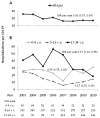Trends in hospitalizations among children and young adults with perinatally acquired HIV
- PMID: 24378943
- PMCID: PMC4215549
- DOI: 10.1097/INF.0000000000000126
Trends in hospitalizations among children and young adults with perinatally acquired HIV
Abstract
Background: Contemporary trends in hospitalization patterns among perinatally HIV-infected (PHIV) patients are unknown. We describe rates and reasons for hospitalizations stratified by age group during 2003-2010 within a large cohort of PHIV patients.
Methods: 579 PHIV patients engaged in care at 6 geographically diverse pediatric HIV centers affiliated through the HIV Research Network were included. Modified Clinical Classification Software assigned primary ICD-9 codes into diagnostic categories. Analysis was performed using negative binomial regression with generalized estimating equations.
Results: There were 699 all-cause hospitalizations. The overall rate for the full cohort was 19.9/100 person-years, and overall rates for 0-4, 5-16 and 17-24 year-olds were 25.1, 14.7 and 34.2/100 person-years, respectively. Declines were seen in unadjusted all-cause rates for the whole group [incidence rate ratio per year, 0.93 (0.87-0.99)] and for 5-16 [0.87 (0.76-0.99)] and 17-24 year-olds [0.87 (0.80-0.95)]. After adjustment for CD4, HIV-1 RNA and demographics, rates were no longer declining. Non-AIDS-defining infections and AIDS-defining illnesses together caused 349 (50%) admissions. Declines in these categories drove the overall declines in unadjusted rates. No increases over time were seen for cardiovascular, renal or any other diagnostic categories.
Conclusions: While the declines in hospitalizations are reassuring, continued efforts are needed to address the persistently high infectious and non-infectious morbidity among PHIV patients. Innovative strategies may be most critical for 17-24 year-olds. Lack of increases in cardiovascular and renal admissions provides modest, preliminary reassurance against severe non-infectious complications from longstanding HIV infection and antiretroviral exposure.
Conflict of interest statement
Figures
References
-
- Buchacz K, Baker RK, Moorman AC, et al. Rates of hospitalizations and associated diagnoses in a large multisite cohort of HIV patients in the United States, 1994-2005. AIDS. 2008;22:1345–1354. - PubMed
-
- Montaner J, Nosyk B, Colley G, et al. The Evolution of the Cascade of HIV Care: British Columbia, Canada 1996-2010. 2013
-
- Agwu AL, Fleishman JA, Rutstein R, Korthuis PT, Gebo KA. Changes in Advanced Immunosuppression and Detectable HIV Viremia among Perinatally HIV-Infected Youth in the Multisite United States HIV Research Network. J Pediatric Infect Dis Soc. 2013:1–9. - PubMed
Publication types
MeSH terms
Grants and funding
LinkOut - more resources
Full Text Sources
Other Literature Sources
Medical
Research Materials


